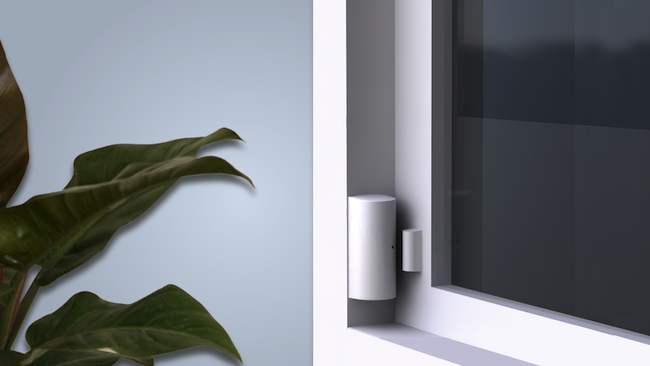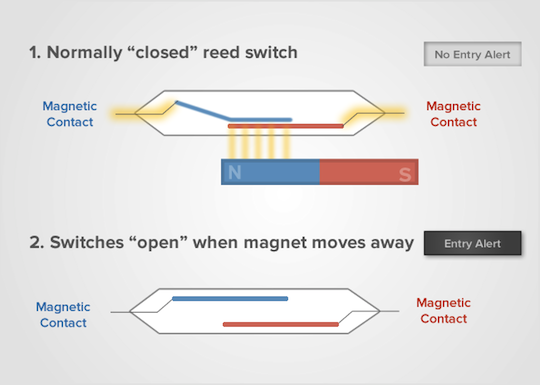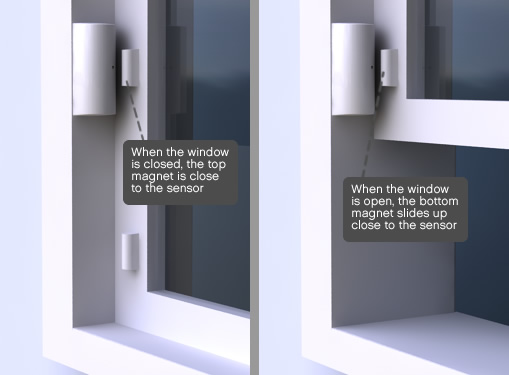 One of the many uses for a door sensor.
One of the many uses for a door sensor.
Entrances and exits are your home's weakest points—and to a burglar, an unsecured door or window
is like a big "WELCOME" sign. That's why door sensors—also known as
"entry sensors," "window sensors," or "contact sensors"— are some of the
most popular home security devices. The earliest electronic home security system
was entirely made up of door sensors—when someone opened a door or
window, it triggered a big vibrating bell in a central part of the home.
Luckily, technology has improved since then, and homeowners are faced
with a wide array of choices. Here's everything you need to know about
today's door sensors: how they work, how to use them, and how to design
the best setup for your home.
HOW DOES A DOOR SENSOR WORK?
Almost all door and window sensors use a "reed
switch" to determine when a protected area has been breached. Reed
switches were invented in Bell Telephone Laboratories in 1936, and are
used in everything from pedal keyboards to laptops (ever wonder how your
computer knows to go to sleep when you close the lid? That's a reed
switch working!). A reed switch consists of
a set of electrical connectors placed slightly apart. When a magnetic
field is placed parallel to the electrical connectors, it pulls them
together, closing the circuit.

Door sensors have one reed switch and one magnet,
creating a closed circuit. If someone opens an armed door or window,
the magnet is pulled away from the switch, which breaks the circuit and
triggers an event. Depending on your setup and what mode your system is
in, this could be a discreet text, a chime alert, or a full-blown
alarm.

HOW ELSE CAN I USE MY DOOR SENSOR?
Because the technology involved in an entry sensor is so elegant, it can be used in a lot of creative ways—especially if you can program different responses for alarm events. Some security companies, such as SimpliSafe, allow customers to decide whether a triggered sensor means a full-on alarm response, an alarm response with a detailed event report sent to your email or phone (a Smart Alert), or a private text or email, without a public alarm event (a Secret Alert). SimpliSafe calls their door sensors "entry sensors" because they can be used in a variety of situations.
Here are some ways to take advantage of those features and get the most out of your entry sensors.
- Doorbell: Your SimpliSafe entry sensor doubles as a doorbell: If your system is off, it will still sound a chime if someone triggers a sensor. Great way to know when your husband has finally brought home dinner—or if your toddler has managed to open a window in his room.
- "Virtual Bouncer":Entry sensors don't just keep out the outside world — they can warn you about breaches within your home, too. Stick one on the entrance to the game room or the door to the liquor cabinet. Rig it up with a Secret Alert so that it only tells you if the seal is broken — so you can crack down on those rule-breakers.
- 24/7 Lifeguard: Have curious little kids who always want to open the pool gate or play with the cleaning supplies? Install some entry sensors, and get immediate and detailed Smart Alerts sent straight to your phone whenever you need to come to the rescue.
- Spy: Savvy SimpliSafe employee Ryan K. positioned his TV right where he likes it, stuck on an entry sensor, and then set up a Secret Alert. "Now I know if anyone moves it," he says. I wish I'd done something similar with my mini-fridge in college.
- Party Fails: Want guaranteed entertainment at your next house party? Put an entry sensor on a medicine cabinet in your bathroom and set up a Secret Alert. You'll get a text message every time someone peeks, and you'll finally know which of your friends can't control their curiosity.
- Protecting Your Outdoor Stuff: Entry sensors are also great for protecting outdoor equipment that you can't keep inside your stronghold—an in-window air conditioner, for example. Stick one half of the sensor on your AC unit and the other on the windowsill, and anyone who tries to nab it will be held accountable. TIP: Although entry sensors are electronics and can't get wet, wrap one in saran wrap or a plastic bag and it will still work just fine.
DOOR SENSOR FAQS
- If I crack my window to let in a breeze while I'm away, will my entry sensor go off?
For extra flexibility with door and window positioning, just install a second magnet. That way the entry sensor has two "safe" positions—say, "window closed" or "window open 6 inches"—and if it's moved from either of those it will trigger an alarm. - Will my entry sensor work with my unusual door/window?Before deciding what sort of door sensor to buy, it pays to check its technical specifications to make sure it fits where you want to put it. A SimpliSafe Entry Sensor's flexible design ensures that it will work with nearly any type of door or window, including sliding doors, double doors, and swinging windows. Click here for specialized entry sensor installation tips. (For certain situations—such as doors with very deep frames—a motion sensor might provide better protection.)
- Should I install my entry sensors in a certain direction?
SimpliSafe entry sensors work just fine upside down, sideways, diagonally—you name it. As long as the magnet is less than two inches from the sensor, it makes no difference how the sensor is positioned. - Is there anywhere I shouldn't install an entry sensor?
Certain metals can, over time, affect the magnets within the sensors. If you are looking to put an entry sensor on a metal object, a thin plastic buffer placed between the metal and the sensor will ensure it remains unaffected. - Could an intruder disable my entry sensor with his own magnet?
Although technically possible, this scenario is very unlikely. "The burglar would need an expensive, powerful magnet," says SimpliSafe Customer Service Manager Ryan K., "and they'd need to know where the entry sensor is inside of the door. If someone was going to do that, it would be someone who had already been in your home and seen where things are." Even if a burglar tried, he'd likely trip the alarm in the process, because reed switches are very sensitive. As Deves, a professional alarm system servicer and SimpliSafe customer, points out, "it is very easy to disturb the reed switches and cause an alarm when you attempt to use a secondary magnet from outside—it usually disturbs the magnetic field and causes an alarm."


No comments:
Post a Comment